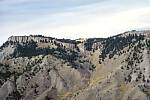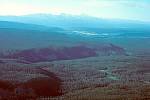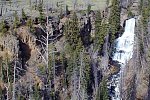Three Volcanic Cycles of Yellowstone
Overview
Three extraordinarily large explosive eruptions in the past 2.1 million years each created a giant caldera within or west of Yellowstone National Park with the spread of enormous volumes of hot, fragmented volcanic rocks as pyroclastic flows over vast areas within times as short as a few days or weeks. The accumulated hot ash, pumice, and other rock fragments welded together from their heat and the weight of overlying material to form extensive sheets of hard lava-like rock. In some sections, these welded ash-flow tuffs are more than 400 m thick! These ash-flow sheets—from oldest to youngest, the Huckleberry Ridge, Mesa Falls, and Lava Creek Tuffs—account for more than half the material erupted from Yellowstone. The enormous outpouring of magma, 280 to 2,450 km3 during each explosive event, led to the collapse of magma-chamber roofs, causing the ground above to subside by many hundreds of meters to form the calderas.
Before and after these caldera-forming events, eruptions in the Yellowstone area produced rhyolitic and basaltic rocks—large rhyolite lava flows and some smaller pyroclastic flows in and near where the calderas collapsed and basalt lava flows around the margins of the calderas.
A general sequence of events was repeated in the evolution of each of Yellowstone's three volcanic cycles:
- A broad area, larger than that which will become the caldera is slowly
uplifted. This uplift reflects the development and rise of large volumes of
rhyolite to form a magma chamber at shallow depths in the Earth's crust.
Stretching of the crust above the inflating magma chamber leads to concentric and
radial fracturing and faulting at the surface, typically accompanied by the
extrusion of lava flows from these fractures.
- At a critical stage in the evolution of the magma chamber, enormous
volumes of the overpressurized rhyolite magma erupt explosively through
the ring-fracture zone created above the magma chamber during inflation
and uplift, producing extensive ash-flow sheets. As the eruptions partly
empty the chamber of its magma, the roof of the magma chamber collapses
along the same ring fractures to produce a large caldera.
- Postcollapse volcanism includes the extrusion of rhyolite lavas and smaller explosive eruptions of pyroclastic flows within or adjacent to the the caldera. In the present-day Yellowstone caldera, lakes formed where streams draining into or along the margin of the caldera were dammed by these thick intracaldera rhyolite flows, including Shoshone, Lewis, Heart, and Yellowstone Lakes. Shortly following collapse, the caldera floor may be uplifted by hundreds of meters in a process known as resurgent doming; this uplift reflects renewed pressure as magma rises again into the magma chamber. Hydrothermal activity (such as hot springs and geysers) occurs during all three stages but, in the third stage, it becomes the dominant or only visible sign at the surface of magmatic activity below.
| The long-term nature of volcanism in this part of North America suggests that
more eruptions will occur as the Yellowstone National Park continues to evolve. The
most recent series of eruptions, 160,000 to 70,000 years ago, extruded
more than 20 thick rhyolite lava flows and domes, most of them within the
youngest caldera. Other postcaldera lavas are basalts, erupted around the margins
of the rhyolitic calderas. Based on Yellowstone's history, the next eruptions
are likely to expel lavas, which might be either rhyolites or basalts, possibly
accompanied by moderate explosive activity. Far less likely would be another
enormous outpouring of material that could lead to a fourth caldera. |




